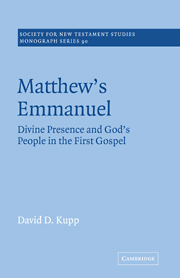Book contents
- Frontmatter
- Contents
- Preface
- List of abbreviations
- 1 Introduction
- 2 Matthew's narrative art
- 3 Reading Matthew's story of divine presence
- 4 Paradigms of presence in the Old Testament
- 5 ‘I am with you’: the Old Testament tradition of the saying
- 6 Matthew 1: the birth of the ‘God-with-us’ Messiah
- 7 Matthew 18.1–20: the presence of Jesus and his έκκλησία
- 8 Matthew 28.16–20: the presence of the risen Jesus
- 9 Jesus' presence and Matthew's christology
- 10 Conclusion
- Bibliography
- Index of passages
- Index of authors
7 - Matthew 18.1–20: the presence of Jesus and his έκκλησία
Published online by Cambridge University Press: 19 January 2010
- Frontmatter
- Contents
- Preface
- List of abbreviations
- 1 Introduction
- 2 Matthew's narrative art
- 3 Reading Matthew's story of divine presence
- 4 Paradigms of presence in the Old Testament
- 5 ‘I am with you’: the Old Testament tradition of the saying
- 6 Matthew 1: the birth of the ‘God-with-us’ Messiah
- 7 Matthew 18.1–20: the presence of Jesus and his έκκλησία
- 8 Matthew 28.16–20: the presence of the risen Jesus
- 9 Jesus' presence and Matthew's christology
- 10 Conclusion
- Bibliography
- Index of passages
- Index of authors
Summary
Matthew 18.20 is unquestionably one of the pivotal texts in the Gospel which bring together explicitly divine presence and the person of Jesus.
ού γάρ είσιν δύο ἤ τρεĩς συνηγμένοι είς τò ὲμòν ὅνομα ὲκεĩ εἰμι ἐν μέσῳ αὐτων.
Many studies of Matthew 18.20 have been dominated by questions of a historical Sitz-im-Leben nature, particularly in light of the saying's apparent resemblance to at least two rabbinic formulations. While evaluating the wisdom of these studies here, we will also presume the passage's participation in a whole rhetorical text, as pursued in the reading of Chapter 3. The purpose of this chapter is to investigate more closely the redactional and theological significance of Matthew 18 and the saying in 18.20, both in the Gospel and in the world of the author.
The story thus far …
In Chapter 3 we noted a number of the plot devices which give Matthew's story its particular orientation around at least three lines of suspense and anticipation established in the narrative introduction of Matthew 1-2: (1) how Jesus will become the saviour of ‘his people’ and be acclaimed by them as God's Emmanuel Messiah; (2) who are to be identified as ‘his people’, in light of his immediate rejection by the leaders of Israel, and (3) how the conflict between Jesus and the Jewish leaders will be resolved.
- Type
- Chapter
- Information
- Matthew's EmmanuelDivine Presence and God's People in the First Gospel, pp. 176 - 200Publisher: Cambridge University PressPrint publication year: 1996



